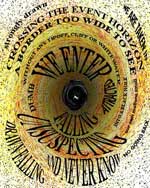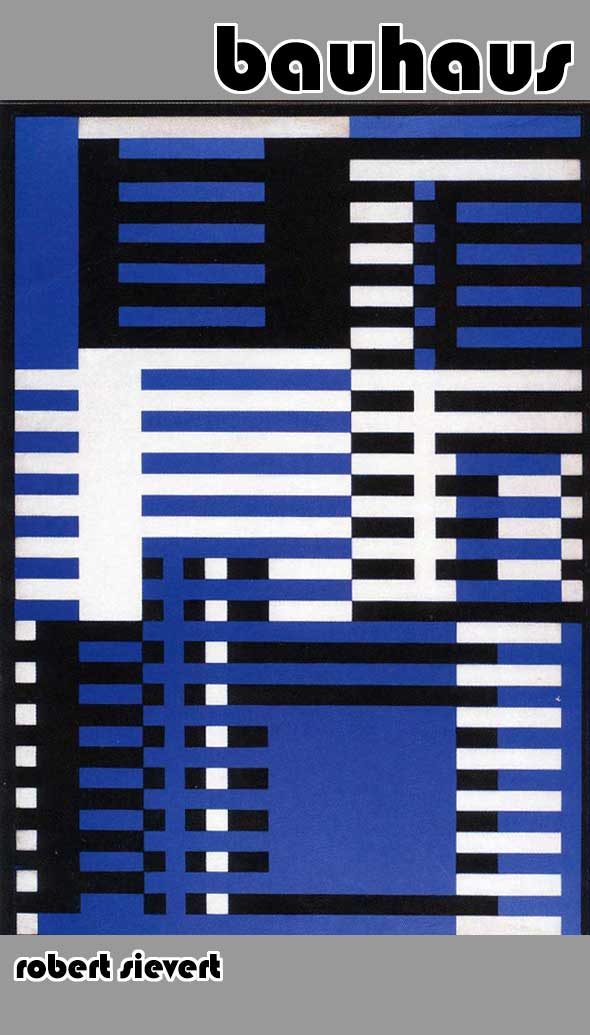
I can remember 1956 clearly;
I had just graduated
from high school and I was in love with German
Art. I thought the Bauhaus was the most amazing
historic phenomenon and because of my youth did
not realize it had all happened only 20 to 30
years before then. I saw a magnificent exhibit
of Paul Klee at the newly designed futuristic
World House Gallery. I came in possession of a
MoMA book on the Bauhaus. I listened endlessly to
Kurt Weill music and poured through books on
Bauhaus era Art. I began my studies at Parsons
School of Design in their Industrial Design
department. Many of the faculty there came from
Yale and in some way represented a continuance
from the Bauhaus.
I forgot most of this until last month when then I
visited MoMA to see the new exhibit they have
mounted on the Bauhaus. As I walked through the
galleries it all came back and once again I came
under the influence of the Bauhaus.
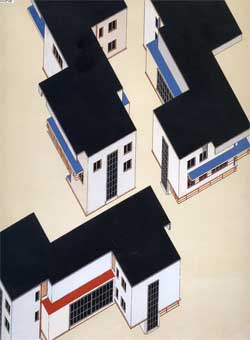
The Bauhaus was an experimental art school in
Germany with the utopian ambition of bringing
forth new forms of spatial design and artistic
production that would in turn inspire a new more
communal way of life. It lived in three locations,
at first in Weimar, next in a magnificent building
designed by Walter Gropius in 1925. Forced to
abandon this building by the Nazi Party in 1928,
they tried to relocate in Berlin.
The exhibit is divided into three sections of
color-coded galleries. Each section for a time and
location of the Bauhaus. The school was originally
organized in the Weimar Republic when architect,
Walter Gropius envisioned a new kind of format for
the existing arts and crafts school. He wanted to
include new materials and machine technology into
the schools curriculum.
 Next Gropius designed a magnificent new home for
the Bauhaus in Dessau in 1925. One can get a
feeling of the building from the famous Oscar
Schlemmer painting of the stairway done in 1932..
This painting became a New York icon for Modern
Art and hung for many years in the stairwell of
the original MoMA. They were forced out of this
building in 1928 and moved to Berlin. By 1933 the
Nazi Party had had enough and closed the school
down for good. Most of the faculty moved on to the
United States where they continued with their
ideas at Black Mountain College and finally Yale
University.
Next Gropius designed a magnificent new home for
the Bauhaus in Dessau in 1925. One can get a
feeling of the building from the famous Oscar
Schlemmer painting of the stairway done in 1932..
This painting became a New York icon for Modern
Art and hung for many years in the stairwell of
the original MoMA. They were forced out of this
building in 1928 and moved to Berlin. By 1933 the
Nazi Party had had enough and closed the school
down for good. Most of the faculty moved on to the
United States where they continued with their
ideas at Black Mountain College and finally Yale
University.
The current show at MoMA, which runs through
January 25, 2010, includes many projects completed
by both faculty and students. The faculty included
Paul Klee, Josef and Annie Albers, Laszlo Moholy
Nagy, Herbert Bayer, Josef Itten, Oskar Schlemmer
and Lyonel Feiniger. One of the things that
struck me was the condition of the art on view.
Because a lot of it was student work the quality
of the paper had deteriorated and was yellowed and
curled. This was especially true in the Color
Theory section. Perhaps because this art was
industrial-oriented it did not have the archival
attention given to most fine art.
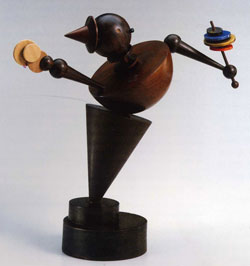 The Bauhaus represented a forward-looking Europe.
In the early 20th century there was a hunger for
Modernism, which was seen as a way to escape the
dark, dismal past of Neoclassical and gothic
design. Much of the design was based on a
confidence in the technological and mechanical.
Gropius was an architect that developed clean
uncluttered designs for buildings using glass and
steel. He wanted to spread that clean esthetic
into the decorative arts. He wanted to reconcile
Art and the industrial society.
The Bauhaus represented a forward-looking Europe.
In the early 20th century there was a hunger for
Modernism, which was seen as a way to escape the
dark, dismal past of Neoclassical and gothic
design. Much of the design was based on a
confidence in the technological and mechanical.
Gropius was an architect that developed clean
uncluttered designs for buildings using glass and
steel. He wanted to spread that clean esthetic
into the decorative arts. He wanted to reconcile
Art and the industrial society.
Color Theory was an important part of the
curriculum. Albers and Klee did extensive projects
in this area. Much of Klee's work seems to be
directly tied to Color Theory.
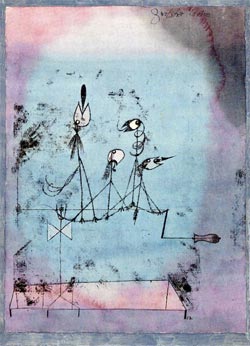 Klee's work consisted of sensitive watercolors of
grids and mechanical designs. It was really
exciting to see his "Twittering Machine" a
watercolor and ink drawing, which I loved so much
as a youth. Here Klee puts forth his wit and a bow
to Modernism in a small delicate drawing of
mechanical birds. Klee also taught drawing and
there were some of his pedagogical designs. They
did not generate much excitement beyond giving
examples of his hatched and scrawling sense of
line.
Klee's work consisted of sensitive watercolors of
grids and mechanical designs. It was really
exciting to see his "Twittering Machine" a
watercolor and ink drawing, which I loved so much
as a youth. Here Klee puts forth his wit and a bow
to Modernism in a small delicate drawing of
mechanical birds. Klee also taught drawing and
there were some of his pedagogical designs. They
did not generate much excitement beyond giving
examples of his hatched and scrawling sense of
line.
Albers developed a life long study of the
interactive nature of color. His Color Theory
followed him through his career that ended with
his being the chairman of the Design Department at
Yale until his death in 1953. In this exhibit
examples of color studies were done in oil paint,
gouache, watercolor and glass. There were
beautiful glass light boxes where pieces of
colored glass, were mounted on grids and light
shown through them. Albers went on to paint his
iconic "Homage to the Square" series which were
seen in New York galleries during the popularity
of Abstract painting. Their cool geometry was
always an alternative to the brushy art of the
day.
Another painting that interested me was a
reclining nude of Josef Itten. Painted in the
20's, it was a figure laid out across a grid.
Related to Cubism, but not invested with the push
and pull of space seen in the Cubist work of the
previous decade the painting had innocence that
charmed me. German art was fighting hard to move
into the Modernist era but not quite sure how to
manage it.
The many pieces of furniture seemed to come
directly out of the IKEA catalogue. Of course this
is an unfair statement as actually the design
represented that spare Nordic sensibility.
 Stagecraft was part of the curriculum. An
important part was Schlemmer's mechanical
marionettes. Beautiful puppets based on the
geometric and mechanical. There was an entire case
of these puppets that really intrigued me. Most of
the designs for the puppets lacked organic form,
and instead there was mechanical basis to the
designs. Repetition and rhythmic forms were used
to create. Themes Schlemmer designed in a stage work,
Ballet Mechanique in 1923, which many of these
puppets were studies for.
Stagecraft was part of the curriculum. An
important part was Schlemmer's mechanical
marionettes. Beautiful puppets based on the
geometric and mechanical. There was an entire case
of these puppets that really intrigued me. Most of
the designs for the puppets lacked organic form,
and instead there was mechanical basis to the
designs. Repetition and rhythmic forms were used
to create. Themes Schlemmer designed in a stage work,
Ballet Mechanique in 1923, which many of these
puppets were studies for.
 Most of the fabrics on view were the product of a
weaving workshop run by Alber's wife Anni. She
produced many wall hangings. Anni Albers was
experimental in her work and used different fiber
such as rayon mixed with linen, wool and silk. The
fabrics were of all sizes and had interlacing
geometric forms woven into them. Some how it all
fit together, the spare furniture design, the
geometric themes carry through most of the work
produced by Bauhaus artists
Most of the fabrics on view were the product of a
weaving workshop run by Alber's wife Anni. She
produced many wall hangings. Anni Albers was
experimental in her work and used different fiber
such as rayon mixed with linen, wool and silk. The
fabrics were of all sizes and had interlacing
geometric forms woven into them. Some how it all
fit together, the spare furniture design, the
geometric themes carry through most of the work
produced by Bauhaus artists
The Bauhaus has to be seen as the kick-start of
Modernism in German art. They did not have the
excitement of the Paris School with Cubism and
Dada but they did hunger for the new. They were
strong in group effort and collectively made their
way into the 20th century. Unfortunately all this
effort for a new utopian industrial society was
wiped out by the Third Reich and it was moved to
America. We are still in debt to the leaders of
the Bauhaus for their vision.
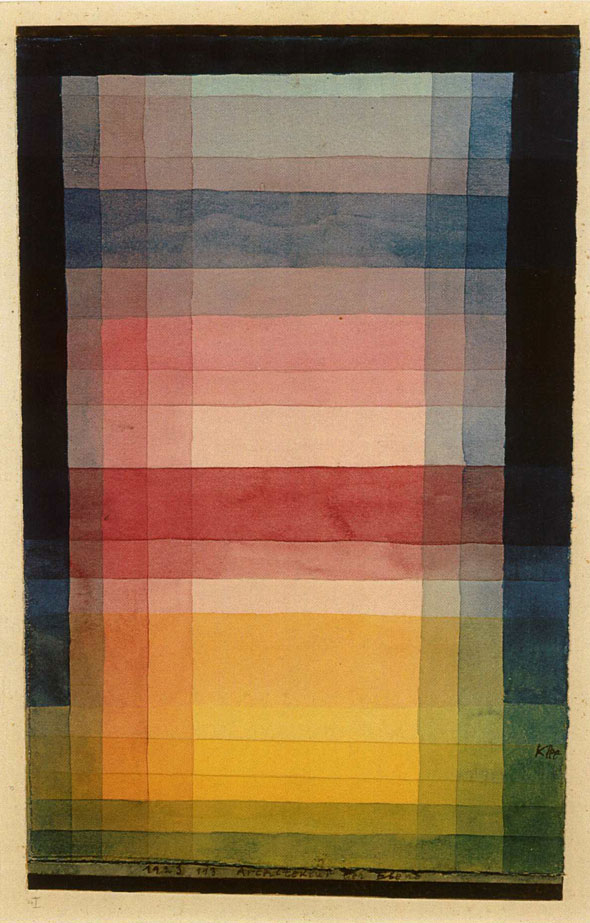
Paul Klee: Color Study
Paul Klee / Color Study
|
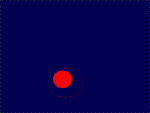
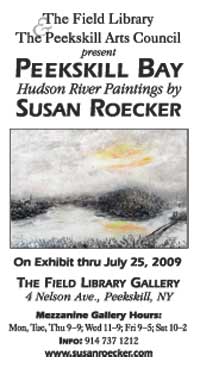




 Next Gropius designed a magnificent new home for
the Bauhaus in Dessau in 1925. One can get a
feeling of the building from the famous Oscar
Schlemmer painting of the stairway done in 1932..
This painting became a New York icon for Modern
Art and hung for many years in the stairwell of
the original MoMA. They were forced out of this
building in 1928 and moved to Berlin. By 1933 the
Nazi Party had had enough and closed the school
down for good. Most of the faculty moved on to the
United States where they continued with their
ideas at Black Mountain College and finally Yale
University.
Next Gropius designed a magnificent new home for
the Bauhaus in Dessau in 1925. One can get a
feeling of the building from the famous Oscar
Schlemmer painting of the stairway done in 1932..
This painting became a New York icon for Modern
Art and hung for many years in the stairwell of
the original MoMA. They were forced out of this
building in 1928 and moved to Berlin. By 1933 the
Nazi Party had had enough and closed the school
down for good. Most of the faculty moved on to the
United States where they continued with their
ideas at Black Mountain College and finally Yale
University.





